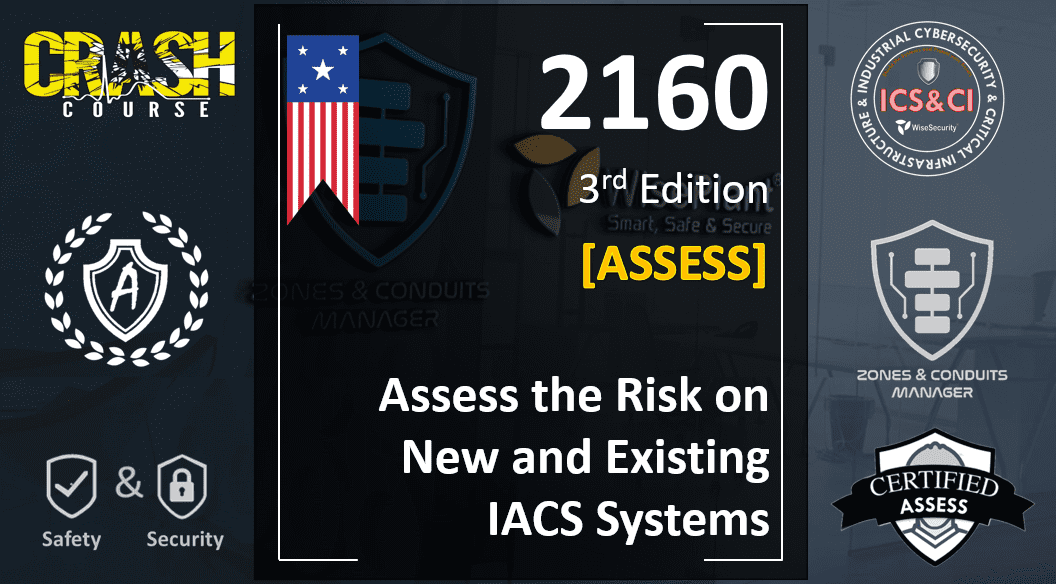Recommend or Share:
The purpose of the 2160 course is to manage the development of the activities necessary to execute the industrial cyber risk assessment, complying with all the requirements of the ISA/IEC-62443 series of standards, easily, quickly and ensuring compliance.
The methodology for the correct assessment of cyber risks is essential to make the right decisions with the main objective of creating industrial infrastructures resilient to all types of threats, even the most persistent.
The course is developed entirely with the practical methodology WBS (Cybersecurity Framework) based on proven experience, covering 100% the needs of the industrial cyber risk assessment phase for existing or new systems.
At the end of the 2160 course, you will be able to:
- Understand the requirements of the ISA/IEC-62443 series of standards for the Cyber Risk Assessment (ASSESSMENT) phase.
- Develop clarity on the deliverables to be produced at the end of each of the activities.
- Develop all activities successfully, making optimal use of resources and time.
- Correctly identify the system under consideration, whether these systems are existing or future.
- Evaluate the capabilities of the organization, its good practices, and identify potential opportunities for improvement.
- Identify all potential consequences to be avoided and mitigated during decision-making.
- Develop reasonable and adequate vulnerability studies for an accurate risk assessment.
- Participate in and/or lead a detailed cyber risk assessment based on realistic consequences.
- Make good decisions consistently with other industrial risk disciplines.
- Develop a clear and effective action plan for risk reduction according to the company’s risk matrix and risk tolerance.
Contents of Course 2160:
- Introduction to industrial risk assessment.
- ISA/IEC-62443 Standards
- Popular regulations (NIST, NERC, C2M2,…)
- Objectives, concepts and necessary definitions.
- Activities to be developed for the correct risk assessment.
- Necessary inputs and outputs to be produced with each activity.
- Identification and evaluation of the governance layer (GOV).
- Strengths and weaknesses,
- Potential opportunities for improvement.
- Identification and evaluation of the system under consideration (SUC).
- Zones and Ducts,
- Vulnerabilities
- Identification and evaluation of industrial processes (AUC).
- Criticality or high-level risk assessment,
- Identification of potential consequences.
- Detailed risk assessment, results to be produced.
- Operational (industrial) risk matrices,
- Determination of objective safety levels (SLT)
- Elaboration of risk scenarios,
- Risk assessment and mitigation decision-making.
- Evaluation of the effectiveness and efficiency of existing countermeasures.
- Determination of countermeasures.
- Optimal segmentation of the SUC.
- Preparation of necessary reports.
Practical exercises to be carried out in class: (optional)
The 2160 course can be taken with or without exercises. The exercises can be: demonstrations acted by the instructor and / or practical exercises to be developed with the participants with the guidance of the instructor. These will depend on the particular modality of the course (On demand, face-to-face, virtual).
- Identification of devices using different techniques and tools, automatic and manual.
- Interpretation of the reality of the SUC and modeling of zones and ducts.
- Identify technological vulnerabilities (CVEs,..), procedural/administrative, and physical/mechanical using specific tools.
- Interpret the results of a HAZOP or industrial process risk study.
- Initial or High-Level Risk Assessment (HLRA)
- Detailed Zone and Conduit Risk Assessment (CPHA)
- Produce reports with recommendations for improvement to be implemented in the SuC, the plant and the organization.
Deliverables:
- Course Material.
- Access to the Educational Campus.
- Complementary material in digital form available on the educational campus.
Requirements:
It has no specific requirements. It is recommended that the professional has knowledge of the following topics:
- Systems for supervision and automation of industrial processes.
- Industrial protocols, such as: Modbus, Profibus, Ethernet/IP, OPC or others.
- Safety and/or functional safety instrumented systems. ISA84 Committee Standards.
- Experience in plants and industrial processes.
- Symbology of industrial processes (ANSI/ISA Standard 5.1).
- ISA95 Industrial Data Flow and Information Management Standard.
- Industrial cybersecurity standards ISA/IEC-62443 published by the ISA99 committee.
- Information cybersecurity (IT) and/or domain of data networks.
Certificates:
A first certificate of knowledge is issued upon completion of the course
- Certificate: “Cyber Risk Assessment Practitioner in New and Existing Industrial Systems”
- CRE credits: 1,6
- The certification exam is taken in class at the end of the course. Available in Spanish, Portuguese, and English.
A second certificate of experience is issued after practical implementation in real projects.
- Certificate: “Expert in Cyber Risk Assessment in New and Existing Industrial Systems”
- CRE credits: cumulative, depending on the duration of the activities carried out by the practitioner.
- The certificate is issued after a demonstration of practical experience with the active participation of the practitioner in real projects making use of the methodology.
Recognitions:
All participants who meet the course requirements and successfully pass the final exam with a good grade will be awarded a Digital Badge. The Digital Badge certifies that the participant has attended the 2160 training course and has executed the final evaluation test with a good grade, verifying that said participant has assimilated the new knowledge reasonably.
All practitioners who develop and demonstrate active participation in the different activities of the methodology, and who have accumulated a minimum number of hours of attendance in each of the specific activities. They will be eligible to obtain the corresponding certificate of experience. Supervision by a certified project leader is required. Process similar to the hours of an airplane pilot.



